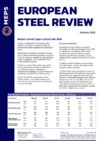Optimism slowly returning to the EU steel market?
The mood in the EU steel market, in June, is one of cautious optimism. Demand is beginning to improve, albeit modestly, following the easing of lockdowns and coronavirus restrictions across the continent.
Activity, in steel-consuming sectors, is gradually coming back to life. Operating rates at many businesses had fallen below fifty percent, and even lower in numerous cases, during recent months. The construction industry is performing satisfactorily. The automotive manufacturers have been the worst hit and they continue to struggle.
Inventories, at distributors and service centres, are sufficient for current needs. Resale prices are likely to remain under negative pressure, in the near term, as many stockists offload excess material, in an attempt to generate cash flow. However, this is resulting in pockets of stock shortages – particularly for customers who require large tonnages at short notice.
Many businesses are planning to make steel purchases in the next two to three months. Nevertheless, any increase in domestic mill sales volumes is expected to be restricted by the slow recovery in end-user activity. Concern exists about the lack of new projects. Several European mills may take extended summer shutdowns, in order to tighten market supply and push steel transaction values upwards.
Input costs rise
Raw material expenditure has risen, in the past month. This, coupled with weakening steel selling figures, is putting significant pressure on mill profit margins. European steelmakers are likely to attempt cost-based price increases, in the third quarter. Consequently, MEPS predicts that transaction values are nearing the bottom of the current cycle.
Several European governments have announced stimulus measures, particularly for the automotive sector. However, these are targeted at electric vehicles which have low production and sales volumes, at present. This will do little to boost steel shipments to car manufacturers, this year. Nevertheless, the cash injections into the economy will aid the overall EU steel market recovery.
Credit limits have been reduced, for many European companies. Although this is yet to create any significant problems in the market, it will restrict steel purchase volumes and could slow the revival, in the second half of 2020.
Gradual upturn expected
The speed and shape of the recovery will become more apparent by the autumn, when businesses fully adapt to the new ways of working and consumers return to the market. Early in the pandemic, many predicted a strong bounce back. However, a more gradual upturn is now expected, this year.
The growth in European steel sales volumes is expected to continue, in 2021. Restocking activities could aid the pickup in demand on the mills, at that time. Nevertheless, total shipments, next year, could remain below those recorded in 2019. Moreover, a second wave of Covid-19 infections would impede any recovery in the EU steel market.

Source:
European Steel Review
The MEPS European Steel Review is an informative, concise and easy-to-use monthly publication, offering unique professional insight into European carbon steel prices.
Go to productRequest a free publication





